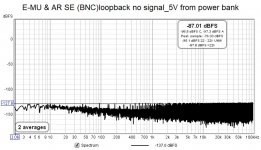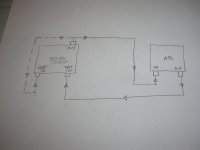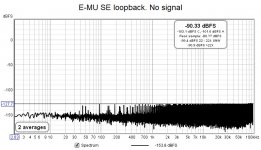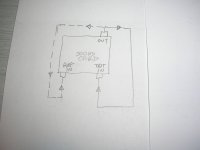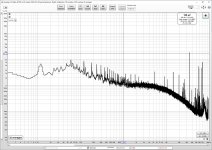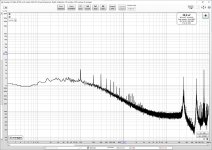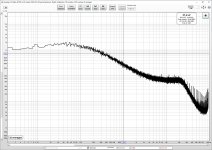Someone asked me:
I did not notice a minimum load specified for the SilentSwitcher. Is it OK to let the 5V output float with no load?
Yes
Also I did not see a maximum load capacitance specified for the +/-15V supply outputs.
For use with Peter Millet's sound card interface, would the Silent Switcher tolerate the sound card interface 330 uF (ESR=68 mohm) capacitors as part of the output load?
I would only consider using one set of 330 uF caps.
These 330uF caps make me a little nervous for LDO stability and reliability.
Pete uses these big caps to squash any switching noise coming from the DC-DC converter he uses. If you use the Silentswitcher you should delete them. The SS has sufficient on-board decoupling. If you want, you can put some good quality 1 or 10uF at the interface board.
Where will you connect the Silentswitcher? Delete the original DC-DC converter and connect it there?
BTW the interface also needs +5V so that can be taken from the SS as well.
Jan
I did not notice a minimum load specified for the SilentSwitcher. Is it OK to let the 5V output float with no load?
Yes
Also I did not see a maximum load capacitance specified for the +/-15V supply outputs.
For use with Peter Millet's sound card interface, would the Silent Switcher tolerate the sound card interface 330 uF (ESR=68 mohm) capacitors as part of the output load?
I would only consider using one set of 330 uF caps.
These 330uF caps make me a little nervous for LDO stability and reliability.
Pete uses these big caps to squash any switching noise coming from the DC-DC converter he uses. If you use the Silentswitcher you should delete them. The SS has sufficient on-board decoupling. If you want, you can put some good quality 1 or 10uF at the interface board.
Where will you connect the Silentswitcher? Delete the original DC-DC converter and connect it there?
BTW the interface also needs +5V so that can be taken from the SS as well.
Jan
Is it not much simpler just to increase the input power?
What are you using now?
Jan
My answer arrived in the mail today and fits in my palm! A MeanWell MPM-30-5-ST! Gobs of current available!
Blocked
A little expensive, but it mounts on Modushop chassis baseplate easily and has screw terminals. Plus, it’s Class II rated.
Now the Silent Switcher will easily pump out even 300mA @ +/- 15VDC. Or perhaps more?!
Best,
Anand.
The Silentswitcher runs fine on a USB charger, or, for stellar performance, a Powerbank.
Transformers & rectifiers are sooo 20th century ;-)
Jan
20th century... green before anyone knew what it meant!
My answer arrived in the mail today and fits in my palm! A MeanWell MPM-30-5-ST! Gobs of current available!
Blocked
A little expensive, but it mounts on Modushop chassis baseplate easily and has screw terminals. Plus, it’s Class II rated.
Now the Silent Switcher will easily pump out even 300mA @ +/- 15VDC. Or perhaps more?!
Best,
Anand.
That's a nice unit, and well isolated. I wonder how quiet the output is.
Anand, could you do me a favor and measure the capacitance between the input and output, if you have that capability?
Jan
Last edited:
The Silentswitcher runs fine on a USB charger, or, for stellar performance, a Powerbank.
Transformers & rectifiers are sooo 20th century ;-)
Jan
I had a few USB chargers around and it seems that quality of external 5Vdc source does matter.
AR draws around 350mA from it’s 5V DC source. Higher current capacity of 5V source doesn’t equate to cleaner output.
See spurae at the audio output of AR with different 5V sources.
Here E-MU0404 & AR in loopback, no signal.
AR in SEin -SEout.
AR gain +18dB (Auto).
E-MU Gnd Lift sw to Lift
1: USB Charger (0.55A) OLYMPUS Model:F-2AC-3D
2: USB Charger (3A) Schenzhen Jihongda Power Co. LTD Model:JHD-AP015E-050300BU1-C
3: Battery Power Pack (1A out) Powertech Model: PT-802 (10000mAh)
4: USB Charger (1.55A) SAMSUNG Model: EP-TA50EWE
5: USB Charger (0.7A) LG Model:STA-U17ET
6: USB Charger (2A) XIAOMI Model:MDY-08-EO
7: USB Charger (0.35A) Jiangsu Chenyang Electron Co.Ltd Model: 2G61907W240579C
8: USB Charger (0.5A) SONY Model: AC-UB10C
9: USB out Desktop PC Lenovo ThinkCentre M91p with an internal 600W PSU CoolerMaster SILENTPro
10: USB out Notebook TURBO-X with an external 12V/3A PSU
George
Attachments
-
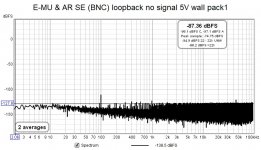 1 E-MU and AR SE (BNC) loopback no signal_5V wall pack1.jpg116.8 KB · Views: 348
1 E-MU and AR SE (BNC) loopback no signal_5V wall pack1.jpg116.8 KB · Views: 348 -
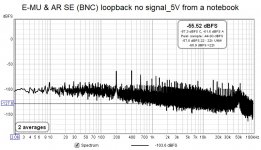 10 E-MU and AR SE (BNC) loopback no signal_5V from a notebook.jpg123.4 KB · Views: 111
10 E-MU and AR SE (BNC) loopback no signal_5V from a notebook.jpg123.4 KB · Views: 111 -
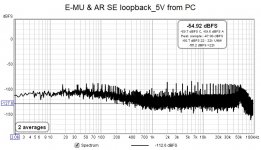 9 E-MU and AR SE (BNC) loopback no signal_5V from PC.jpg117.1 KB · Views: 101
9 E-MU and AR SE (BNC) loopback no signal_5V from PC.jpg117.1 KB · Views: 101 -
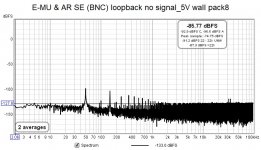 8 E-MU and AR SE (BNC) loopback no signal_5V wall pack8.jpg119.1 KB · Views: 99
8 E-MU and AR SE (BNC) loopback no signal_5V wall pack8.jpg119.1 KB · Views: 99 -
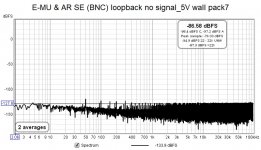 7 E-MU and AR SE (BNC) loopback no signal_5V wall pack7.jpg118.1 KB · Views: 102
7 E-MU and AR SE (BNC) loopback no signal_5V wall pack7.jpg118.1 KB · Views: 102 -
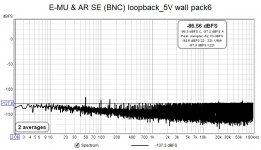 6 E-MU and AR SE (BNC) loopback no signal_5V wall pack6.jpg115.4 KB · Views: 104
6 E-MU and AR SE (BNC) loopback no signal_5V wall pack6.jpg115.4 KB · Views: 104 -
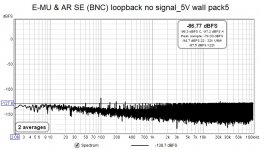 5 E-MU and AR SE (BNC) loopback no signal_5V wall pack5.jpg117.8 KB · Views: 327
5 E-MU and AR SE (BNC) loopback no signal_5V wall pack5.jpg117.8 KB · Views: 327 -
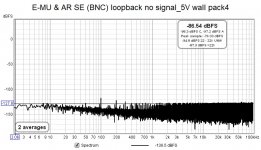 4 E-MU and AR SE (BNC) loopback no signal_5V wall pack4.jpg117.8 KB · Views: 332
4 E-MU and AR SE (BNC) loopback no signal_5V wall pack4.jpg117.8 KB · Views: 332 -
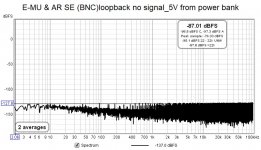 3 E-MU and AR SE (BNC) loopback no signal_5V from power bank.jpg118.3 KB · Views: 335
3 E-MU and AR SE (BNC) loopback no signal_5V from power bank.jpg118.3 KB · Views: 335 -
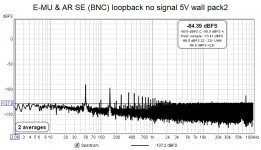 2 E-MU and AR SE (BNC) loopback no signal_5V wall pack2.jpg119.2 KB · Views: 346
2 E-MU and AR SE (BNC) loopback no signal_5V wall pack2.jpg119.2 KB · Views: 346
That's interesting George, thanks for taking the trouble.
What I find of note is the hash when fed from the notebook or laptop.
Could it be that in those cases there is a gnd connection between the notebook/laptop and the AR which is not the case when fed from standalone packs?
Jan
What I find of note is the hash when fed from the notebook or laptop.
Could it be that in those cases there is a gnd connection between the notebook/laptop and the AR which is not the case when fed from standalone packs?
Jan
May be Jan. But it's also the HF dirt which pops up at intervals not related to 50Hz.
But to make it clear, AR fed by a clean 5V adds nothing to the noise floor spurae of the sound card’s noise floor.
First att. schematic of E-MU loopback and second att. it’s noise floor.
Third att. Schematic of E-MU & AR loopback and forth att it’s noise floor (Battery power bank as 5V source)
George
But to make it clear, AR fed by a clean 5V adds nothing to the noise floor spurae of the sound card’s noise floor.
First att. schematic of E-MU loopback and second att. it’s noise floor.
Third att. Schematic of E-MU & AR loopback and forth att it’s noise floor (Battery power bank as 5V source)
George
Attachments
That's interesting George, thanks for taking the trouble.
What I find of note is the hash when fed from the notebook or laptop.
Could it be that in those cases there is a gnd connection between the notebook/laptop and the AR which is not the case when fed from standalone packs?
Jan
I have also measured much higher noise from SilentSwitcher when powered by computer USB port. Especially on +15V/-15V output.
Here are noise measurements of SilentSwitcher -15V output when powered by
1. battery power pack 10000mAh
2. wall-wart
3. computer USB
Sorry about the varying y-axis. Even the battery pack seems to have some hash above 30kHz. This hash is not visible if powered by 8x1.2V NiMH accus.
Attachments
Last edited:
A battery pack is not just a battery, it has an internal boost switcher to make 5V from the 3.7V battery. So it is possible to get some hash from it, but it is rare.
If you see it check the grounding because 9 out of 10 cases the hash comes in through some surprise ground connection.
Jan
If you see it check the grounding because 9 out of 10 cases the hash comes in through some surprise ground connection.
Jan
I've seen comments here that SilentSwitcher lacks a galvanic USB isolator. Based on the above measurements USB isolator may well be useful. However most stick-type USB isolators have a measly 1W power supply so not really suited for anything practical with SilentSwitcher.
/Martti
/Martti
That's a nice unit, and well isolated. I wonder how quiet the output is.
Anand, could you do me a favor and measure the capacitance between the input and output, if you have that capability?
Jan
Jan,
I do have a nice LCR with a pretty good capacitance meter (it's a Keysight unit) so I'll check the capacitance when I get home.
The datasheet states that the ripple & noise at max load is 80mv P-P ( 28mV RMS ), and it was measured with 20MHz bandwidth and a 47.1uf capacitor in parallel.
Best,
Anand.
What I find of note is the hash when fed from the notebook or laptop.
Could it be that in those cases there is a gnd connection between the notebook/laptop and the AR which is not the case when fed from standalone packs?
Jan
Jan as usual you were right.
The noise seems to be due to USB ground loops. The “noisy” 5V from the main’s powered Notebook’s USB-out is not noisy any more when the Notebook runs on it’s internal battery.
When there is no alternative to using mains powered PCs, laptops or Notebooks for 5V source, then use the same PC’s USB outlets to connect the USB cables of the AR and soundcard plus twist the USB cables together. Both reduce the audio noise-floor pollution.
George
Attachments
-
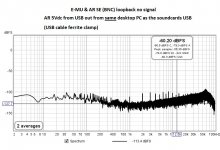 7 USB out from same desktop PC as the soundcards USB (USB cable ferrite clamp).jpg124.1 KB · Views: 75
7 USB out from same desktop PC as the soundcards USB (USB cable ferrite clamp).jpg124.1 KB · Views: 75 -
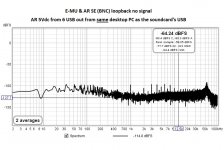 6 USB out from same desktop PC as the soundcards USB.jpg120.2 KB · Views: 78
6 USB out from same desktop PC as the soundcards USB.jpg120.2 KB · Views: 78 -
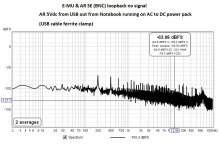 5 USB out from Notebook running on AC to DC power pack (USB cable ferrite clamp).jpg128.8 KB · Views: 246
5 USB out from Notebook running on AC to DC power pack (USB cable ferrite clamp).jpg128.8 KB · Views: 246 -
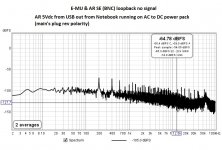 4 USB out from Notebook running on AC to DC power pack (main rev polarity).jpg126.5 KB · Views: 252
4 USB out from Notebook running on AC to DC power pack (main rev polarity).jpg126.5 KB · Views: 252 -
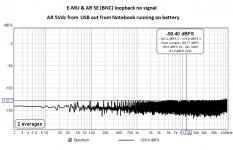 3 USB out from Notebook running on battery.jpg118.4 KB · Views: 253
3 USB out from Notebook running on battery.jpg118.4 KB · Views: 253 -
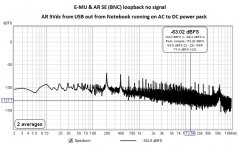 2 USB out from Notebook running on AC to DC power pack.jpg120.9 KB · Views: 260
2 USB out from Notebook running on AC to DC power pack.jpg120.9 KB · Views: 260 -
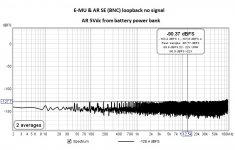 1 battery power bank 128k.jpg112.5 KB · Views: 254
1 battery power bank 128k.jpg112.5 KB · Views: 254 -
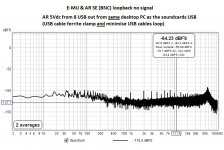 8 USB out from same desktop PC as the soundcards USB (USB cable ferrite clamp and minimise USB c.jpg133.5 KB · Views: 94
8 USB out from same desktop PC as the soundcards USB (USB cable ferrite clamp and minimise USB c.jpg133.5 KB · Views: 94
I had a few USB chargers ...
George
I used mobile chargers and for my use about hours not powerful enough
So went for motor craft 6V batteries with up to 9Ah and will recharge them as needed.
Used an amplified EMI sniffer probs & SSA with EMI so draws even more trouble and have to fix it. Important is to deal with GND isolated (no hum at all), as any power to 5..6V switcher draw impedance/capacity between the main and secondary even in xx pF.
In other words, the connections between batteries and switcher needs shielded too and may batteries boxed too, so we deal with 3 wire connections as GND shield, GND power, Power 5..6V)
Hp
That's a nice unit, and well isolated. I wonder how quiet the output is.
Anand, could you do me a favor and measure the capacitance between the input and output, if you have that capability?
Jan
Jan,
I have an Agilent U1733C LCR meter that runs on a regulated 12VDC supply (not battery).
Set @ 100khz, and with one probe touching AC (L) or AC (N) on one side and the other probe at V+ or G (V-) on the other, I am measuring about 220pf of capacitance. The intrinsic capacitance of the meter itself at this frequency is ~ 1 pf.
At 10khz it is 416 pf.
At 1khz it is 420 pf.
Dunno if that helps or if I need to measure with different parameters.
Best,
Anand.
Last edited:
That's what I wanted to know, thanks. It's not too bad, but some medical grade DC-DC converters I have are only 4pF. It is an important parameter for input-output noise coupling.
Thanks,
Jan
Jan,
Please share your knowledge! Why is it an important parameter? Does the higher capacitance minimize transfer of HF noise from the AC mains due to filtration, LP filter, i.e. the -3dB rolloff calculation Fc = 1/2pi*R*C ?
Do we know what the value of R is in this instance?
Best,
Anand.
Last edited:
- Home
- Vendor's Bazaar
- SilentSwitcher - mains-free +/-15V and 6/5/3.3V power
